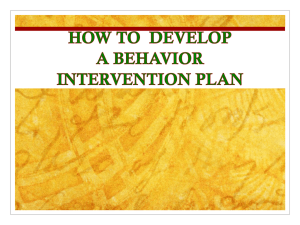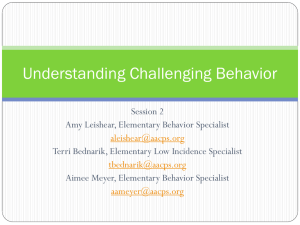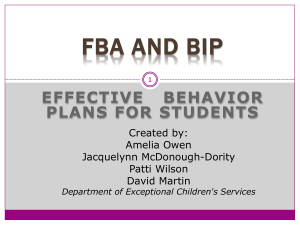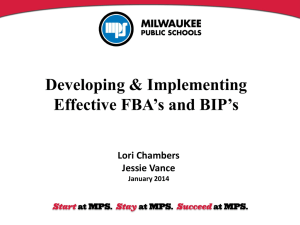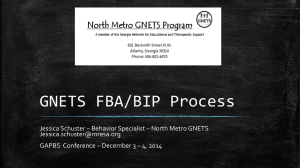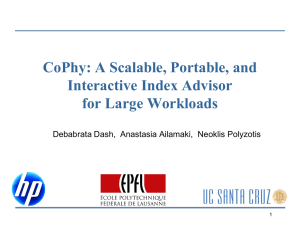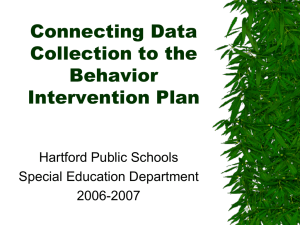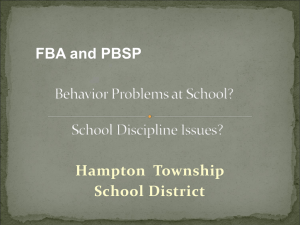Challenging Behavior Session 3 PPT
advertisement
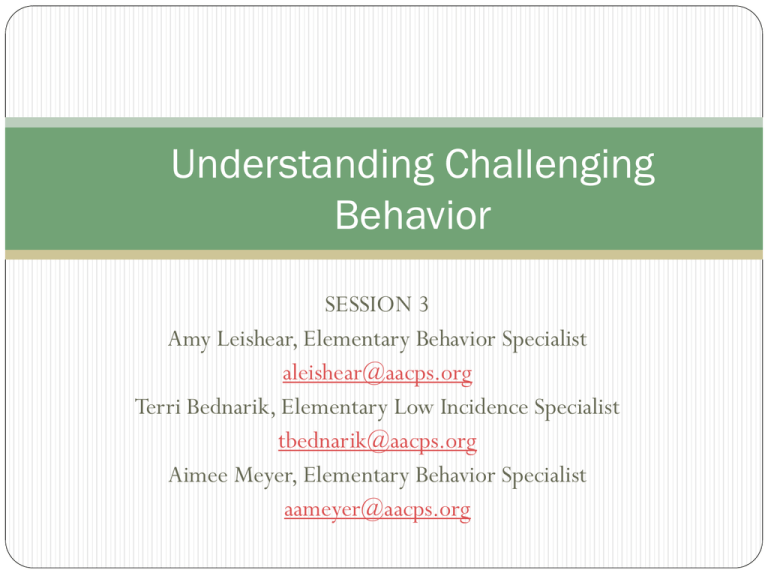
Understanding Challenging Behavior SESSION 3 Amy Leishear, Elementary Behavior Specialist aleishear@aacps.org Terri Bednarik, Elementary Low Incidence Specialist tbednarik@aacps.org Aimee Meyer, Elementary Behavior Specialist aameyer@aacps.org AACPS Division of Special Education Para-educator Training Videos Pre Assessment Name: School: Date: 1. Why is it important to use preventative strategies with students? 2. What does BIP stand for? 3. True or False; The child should be involved with the creation of the BIP? 4. What is a replacement skill? 5. How often is a BIP reviewed? The Big Picture 1. Discuss the process of developing a Behavior Intervention Plan which includes reinforcement schedules, prevention strategies and response strategies 2. Identify best practices for the implementation of a Behavior Intervention Plan. FBA/BIP Steps Overview 1. Define the Interfering Behavior 2. Collect Baseline Data & Identify Antecedents/Consequences 3. Develop a Hypothesis or Summary Statement 4. Develop a BIP, including Reinforcement Schedules, Prevention Strategies and Response Strategies 5. Implement BIP 6. Modify Program as Needed FBA/BIP Step 4: Select strategies that address the impact of the setting, triggers, and consequences which maintain the problem behavior Select behavioral teaching strategies for replacement behaviors Develop scripts/routines for implementation and identify responsibilities of staff Develop an emergency crisis intervention plan if needed FBA/BIP Step 4 (continued) Develop a BIP: Reinforcement Schedules Reinforcement is the most important part of any behavior plan. Reinforcement should be specific to the student. What is reinforcing to one person may not be to another. Reinforcement should match the function. FBA Step 4 (continued) Develop a BIP: Reinforcement Schedules Reinforcement should be isolated and only used to reinforce the replacement behavior. Reinforcement should be scheduled. The reward should match the task. FBA/BIP Step 4 (continued) Develop a BIP: Prevention Strategies Things that we as staff can do to proactively prevent opportunities for challenging behavior to occur. Basic prevention strategies include, but are not limited to: appropriate supervision quality instruction clear and reasonable expectations/procedures actively involving students supportive classroom environment. Sometimes we are able to identify the best prevention strategies following an incident of challenging behavior. FBA/BIP Step 4 (continued) Develop a BIP: Prevention Strategies Classroom modifications may include: sitting in a specific seat, break options, visual supports, reinforcement program, extra attention, prompting, controlled choices, redirection, free time activities, etc. FBA/BIP Step 4 (continued) Develop a BIP: Response Strategies Provide a clear outline/script for staff to follow when responding to target behaviors that does not contradict the identified functions. FBA/BIP Step 4 (continued) Interventions need to be … feasible and appropriate observable and measurable appropriate to setting and age For example: Sensory activities Social stories Praise Sticker charts Visual reminders Verbal reminders Earned privileges Tangible rewards…….. FBA/BIP Step 4 (continued) Teaching Replacement Skills We need to teach students what behaviors are appropriate and those behaviors must serve the need the student is seeking to fulfill. We need to teach, often times explicitly, what he/she should be doing instead of the behavior in concern. For example, social stories, scripts, visual supports. Break down expected behaviors into smaller parts and provide explicit instruction Reinforce demonstration or attempts to demonstrate the replacement behavior. Assist the student in generalizing the behaviors across setting and with different people. Step 5 BIP Implementation Staff Training Observation of Plan Implementation Data Analysis: Compare baseline data with treatment data FBA/BIP Step 5 (continued) Frequency of Plan Review Progress should be reviewed quarterly or on an as needed basis Coincides with Report Card reviews, IEP Reviews Provide information from BIP reviews to the parent or family consistently FBA/BIP Step 5 (continued) Considerations for Evaluation of the plan Evaluation methods should be easy to use Factors to be evaluated must be observable Criteria needs to unambiguous (clear and trackable) Criteria must be directly related to the targeted behavior Progress monitoring should occur across settings and at a variety of times throughout the day Step 6 Modify Program if Needed Should follow consistent BIP implementation and analysis of the data. Meet as a team and include all staff in the discussion before modifications are implemented. Why Do Interventions Fail? Inadequate data for decision making • Outcome objectives not measurable • Low quality plan • Inconsistent implementation of plan • Lack of regular & sustained monitoring • Inadequate support for implementers • Failure to implement/adopt function-based approach • The Big Picture 1. Discuss the process of developing a Behavior Intervention Plan which includes reinforcement schedules, prevention strategies and response strategies 2. Identify best practices for the implementation of a Behavior Intervention Plan. AACPS Division of Special Education Para-educator Training Videos Pre and Post Assessment Name: School: Date: 1. When developing a BIP, what three components should be included? 2. What is a prevention strategy? 3. What is a response strategy? 4. Interventions need to be _________and________, _________and_______, ___________and _________. 5. List at least three things that must be kept in mind when reporting progress to the parent/family.
